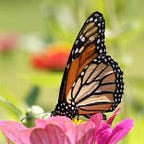FWS Scholar: Robbie Callahan Helps Restore Life to Poplar Island
Carl “Robbie” Callahan grew up in a quiet, rural, small town of the Eastern Shores in Cordova, Maryland. Robbie’s always enjoyed being outdoors and watching wildlife with the Chesapeake Bay as his backyard. He began his career as an intern in the Chesapeake Bay Field Office in Annapolis, Maryland in 2009. Robbie has held various positions, working as a temporary employee, and student with the pathways program, and he finally became a fish and wildlife biologist in 2014 while working on the Poplar Island Restoration Project.
The restoration of Poplar Island is about rebuilding the island — which has been disappearing due to erosion — in the Chesapeake Bay. In 1997, just 10 acres of the original island remained. While erosion is a natural process on barrier islands, conditions that result from human action (such as sea level rise, hardening of shorelines, increase in intensity and frequency of storms) are thought to amplify and accelerate the process unnaturally. New sand is added to the shoreline using clean material dredged from the federal shipping channels leading to the port of Baltimore. This long-term project is helping restore 1,700 acres of critical predator-free island nesting habitat for a multitude of species. Back in 1996, there were only 10 documented bird species using the island, now Poplar Island has over 170 species that have been documented, and over 26 nesting species.
“The greatest part of my job is watching the island grow and develop as different animals utilize the newly created area and the successes and challenges that come along with a project of this size.”
The team from the Chesapeake Bay Field Office hauls used Christmas trees to build waterfowl habitat on Poplar Island, a place where, 10 years ago, wildlife habitat had nearly vanished. Every January since 2005, residents of Easton, Maryland, have put their old Christmas trees on the curb for trash pickup, unaware that their discarded holiday tree will soon become shelter and nesting habitat for black ducks, snowy egrets, red-winged blackbirds, and diamondback terrapins.
Robbie’s co-authored work on “Promoting Change in Common Tern Nest Site Selection to Minimize Construction Related Disturbance” is found in the journal Ecological Restoration. In the face of extensive disturbance, Robbie and his colleagues strive to relocate a common tern (Sterna hirundo) breeding colony from its historical nesting colony to suitable breeding habitat. Poplar Island serves as the largest of only two common tern nesting sites within the Maryland portion of the Chesapeake Bay.
Relocation of the breeding colony allowed for human activity while preserving an important waterbird breeding population.
Robbie works with a variety of species including submerged aquatic vegetation (SAV), restoring marsh habitat, osprey nest counts and banding, common and least tern nest counts and banding, tagging monarch butterflies, and habitat enhancement projects. He attended Salisbury University and earned a bachelor’s in environmental issues and later a master’s in environmental science from Wesley College. Robbie is married with two children, and in his free time he enjoys hunting, fishing, and being outdoors working on his family’s farm.
To learn more about the success of fully relocating common terns nesting colony to another location, read Robbie’s article entitled “Promoting Change in Common Tern Nest Site Selection to Minimize Construction Related Disturbance” is found in the journal Ecological Restoration, discoverable via USFWS Library. #FWSscholar
